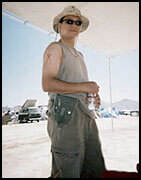Mi Zhou was born in 1962 in China, studied Civil Engineering in college. Following graduation, worked for 13 years as a field engineer for Chinese National Railroad Survey and Design Institute. In 1997, obtained Master degree in Communication Arts from New York Institute of Technology. From 1997 to 2004, worked as art director at Y&R /K&L advertising Inc., New York. Since 2004, resides in San Francisco, USA, working as freelance photographer, mainly focusing on personal projects, and working with non-profit organizations on social documentary.
Recognitions:
2011, 500 Photographers, by Pieter Wisse, Netherlands
2009, The Best Photographer, Saint-Petersburg PHOTO VERNISAGE. Russia
2008, Top 50 Photographers, by Critical Mass, an international portfolio review. USA
Selected Exhibitions:
2013, "The Griots of Oakland", African American Museum and Library, Oakland, USA
2011, "Lost & Found", Florence Moll Gallery at Chic Art Fair, Paris, France
2010, "Burning Man", POLKA Gallery, Paris, France
